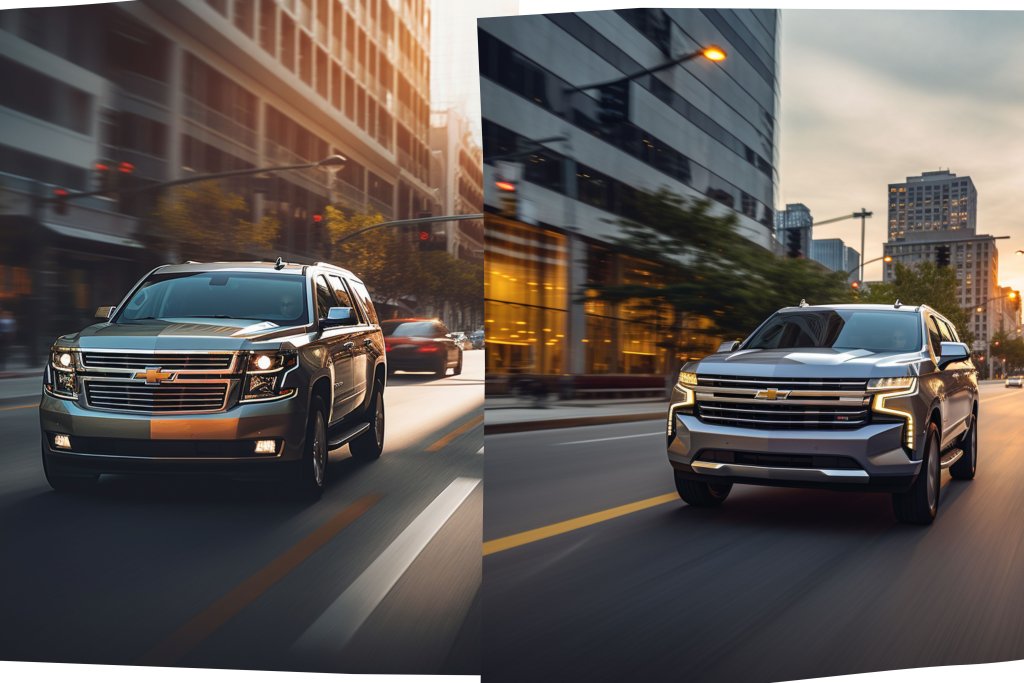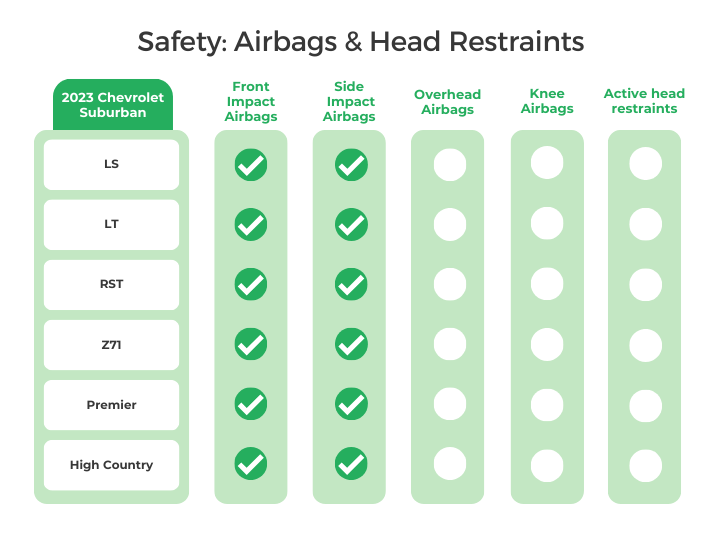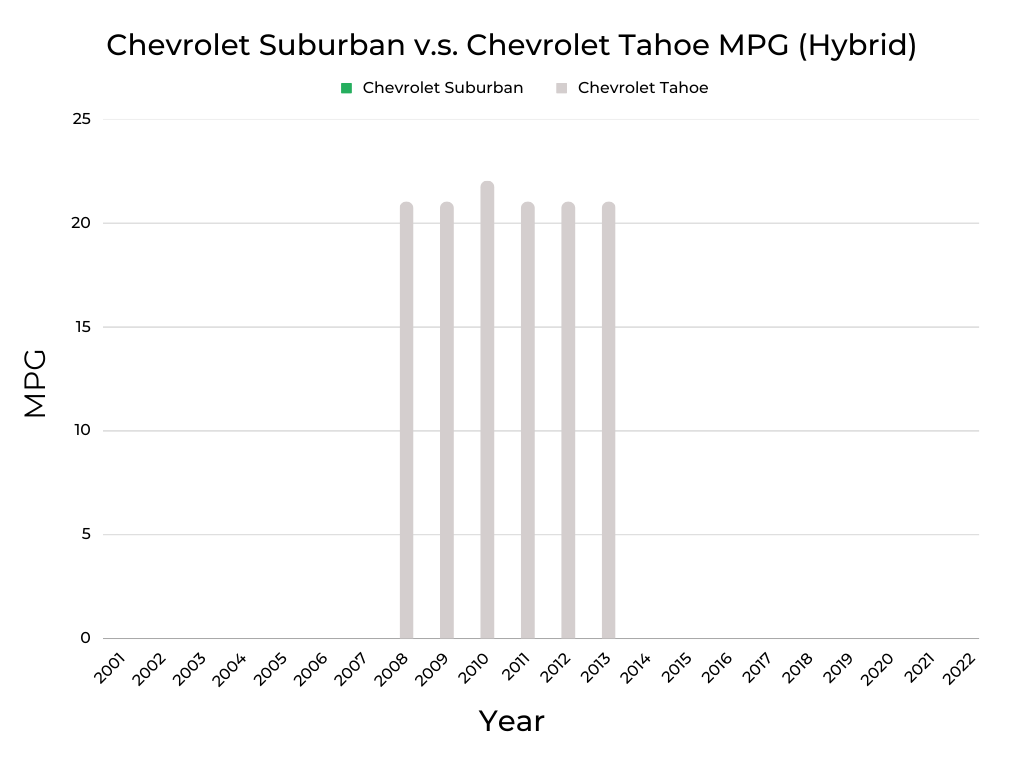While America’s love for utility vehicles is at the forefront of today’s automotive market, SUVs have been part of the motoring landscape for almost a century. One of the pioneers has been the Chevrolet Suburban, which entered production in 1935. It’s the longest, continuously produced vehicle nameplate in the world (General Motors even built Suburbans for Allied use during World War II). That’s quite a heritage.
The Chevrolet Tahoe entered the scene 30 years ago as the automaker reshuffled its SUV offerings to incorporate the smaller S-10 Blazer. Today, the Suburban and Tahoe remain at the top of Chevy’s utility models—a lineup that includes the Trax, Trailblazer, Equinox, Blazer, and Traverse.
While large SUVs like the Suburban and Tahoe aren’t the most popular vehicles on the road, they represent an important transportation solution. There aren’t many automobiles that can accommodate up to nine people or swallow vast amounts of cargo.
This pair of Chevys competes against corporate cousins (GMC Yukon and Yukon XL, and Cadillac Escalade and Escalade ESV), archrival Ford (Ford Expedition and Expedition Max, and Lincoln Navigator and Navigator L), and others (Nissan Armada, Toyota Sequoia, and Lexus LX, to name a few).
Buyers of large SUVs will want to know what the Chevrolet Suburban and Chevrolet Tahoe offer and how they compare to each other. We’ve compiled this information that offers an overview of the 2023 models and explores factors like reliability, market value, and safety for pre-owned Suburbans and Tahoes. FIXD owner surveys supplement these details.
Comparing the Suburban and Tahoe doesn’t yield many surprises—these vehicles share a platform and almost all parts. For example, the Chevys have near-identical average maintenance costs. However, looking at specific individual model years shows that sometimes the Suburban costs more to own than the Tahoe (or vice-versa).
Deciding between a new Suburban or Tahoe comes down to a need for space. The $2,000-$3,000 separating these SUVs probably doesn’t matter much for someone spending $60,000 or more. The Suburban excels in the backseat room and cargo area. Yet, the trade-off is a much longer vehicle.
Besides this Suburban vs. Tahoe matchup, there are other comparisons to check out. Review articles covering Subaru Forester vs. Subaru Outback, Toyota RAV4 vs. Honda CR-V, Honda Odyssey vs. Toyota Sienna, Honda Civic vs. Toyota Corolla, and Toyota RAV4 vs. Subaru Forester.
| Income Bracket | Monthly Financing Cost Range | Cash Purchase Price Range | Chevrolet Tahoe Years | Chevrolet Suburban Years | Best Model Year: | Why? |
| $10k – $15k | $125-$187 | $4,500 – $6,750 | 2006 | 2005 | 2006 Tahoe | Good Reliability Score |
| $15k – $25k | $187-$312 | $6,750 – $11,250 | 2013 | 2011 | 2013 Tahoe | Excellent Reliability Score |
| $25k – $35k | $312-$437 | $11,250 – $15,750 | N/A | 2015 | 2015 Suburban | Strong Reliability, Solid Value |
| $35k – $50k | $437-$625 | $15,750 – $22,500 | N/A | 2017 | 2017 Suburban | Excellent Reliability Score, Good Value |
| $50k – $74k | $625-$925 | $22,500 – $33,300 | 2019 | 2019 | 2019 Tahoe | Solid Engine and Transmission, Good Value |
See the methodology for the table above.
Before you respond to the “For Sale” ad, check out this How to Buy a Used Car article for a step-by-step checklist.
Price History Comparison | Chevrolet Suburban vs. Chevrolet Tahoe
Average Market Value – Based on Owners’ Self-Reported Mileages | Chevrolet Suburban vs. Chevrolet Tahoe

According to a survey from Statista, price is one of the top three considerations among car buyers (fuel economy and safety are the other two). This makes sense because a car’s cost is the starting point for many shoppers. To see how the numbers stack up for pre-owned Suburbans and Tahoes, we turned to sales data from Kelley Blue Book (KBB).
This analysis reveals unsurprising results; these Chevys have mostly consistent values for their respective model years. Keep in mind this pricing is based on private-party transactions, which are usually much lower than retail purchases. You’ll pay 10%–50% more at a dealer. If dealer pricing is out of reach, search for cars with an older model year, more miles, or less equipment.
Whether buying from a private seller or a dealer, mileage impacts the selling price. A car with high miles will be worth less than the equivalent vehicle with fewer miles. The model year also determines the selling price, a factor that’s reflected in the chart data. Suburbans (green) and Tahoes (gray) are worth more as the model year gets more recent.
A few exceptions exist to the steady rise in market values, as shown in the chart. In particular, the 2015-2017 Tahoes are worth more than their counterpart Suburbans. These results are due to the Tahoes having less average mileage, according to FIXD owner surveys.
However, the same doesn’t apply to the 2014 Suburban, which has about 10% greater average mileage than the 2014 Tahoe. Despite this imbalance, the 2014 Suburban is still worth more. There’s no obvious explanation for this; we’ll just have to chalk it up as “one of those things.”
Be sure to read our Best and Worst Years series of articles highlighting the Chevrolet Suburban and Chevrolet Tahoe winners and losers.
Depreciation vs. Maintenance Expenses
Depreciation is a significant hidden cost for new car buyers. After five years, it’s not unusual for a vehicle to lose half its value. A look at the gray line in the above charts shows how this applies to the Suburban and Tahoe. And just to clarify, “depreciation” is the reduction in an asset’s value over time, while “residual value” is that asset’s estimated worth after a pre-determined period.
Either way, you can see how Suburban and Tahoe value nosedives over time. But, this creates an opportunity for savvy used car buyers. After a decade, these Chevys are worth a fraction of their original prices.
Combining this reality with certain model years with a history of reasonable maintenance and repair costs creates a window of opportunity. For the Suburban, the 2003-2013 model years are the “sweet spot” (outlined in black) that combines low residual value and modest upkeep costs. The same applies to the Tahoe, but within a narrower range of model years: 2003-2010.
Higher maintenance costs (covered in greater detail later) account for a reduced selection of sweet-spot Tahoes.
But don’t assume every example within these ranges is a smart buy. Learn more by reviewing the best and worst years of the Chevrolet Suburban and Chevrolet Tahoe. There’s also an at–a–glance summary towards the end of this article.
Reliability Comparison | Chevrolet Suburban vs. Chevrolet Tahoe
Two ratings are at the core of our look at the Chevrolet Suburban and Chevrolet Tahoe.
- The FIXD Reliability Score measures the number of check engine lights recorded for a particular model year by installed FIXD sensors. Think of it as an engine reliability score. While every check engine light doesn’t directly translate into reliability concerns (such as a dead battery or loose gas cap), these indicators still provide insight into a car’s dependability.
- The second rating is the Owner Reliability Score. This is a subjective ranking of how surveyed owners feel about their respective vehicle’s dependability. Each owner estimates how capable their car is for trips of different lengths. A vehicle that can handle a cross-country adventure receives the highest score, while a car only suitable for a quick point A to point B trip gets the lowest score.
Both rankings are based on 1 being the lowest, 10 being the highest, and 5 being the average score.
We’ll also point out that both scores seldom align. The FIXD Reliability Score is determined by a definitive number, the frequency of check engine lights. On the other hand, the Owner Reliability Score is opinion-based. Owners tend to have pride in their automobiles, with higher ratings as a result. At a minimum, those with older vehicles are more accepting of check engine lights. For many, it’s the price of owning an aging car.
Considering that the Suburban and Tahoe share so many components (especially the powertrain), you’d expect engine reliability to be similar. And you’d be partially correct.
For 8 out of the 14 years we have comparative data (2001-2014), the Suburban and Tahoe have the same or similar FIXD Reliability Scores. These Chevys exchange bragging rights for better engine reliability during the remaining years.
However, there’s never more than a three-point gap separating the FIXD Reliability Scores between the Suburban and Tahoe. In other words, while a particular Suburban model year may have higher engine reliability (or alternatively, a specific Tahoe model year), there are no substantial differences in how the engines hold up in these Chevys.
We’ll mention that a lack of data accounts for the 2015-2021 Suburbans not having FIXD Reliability Scores.
Remember that check engine lights (CEL) don’t always mean expensive repair bills. Sometimes, all it takes for a dashboard warning to come on is a loose gas cap or a bad battery. That said, older Suburbans and Tahoes (2001-2008) are particularly vulnerable to CELs.
But the frequency of CELs doesn’t diminish owner confidence in their Chevrolet Suburbans and Tahoes. Most model years of both vehicles are ranked at least 7.5 out of 10.0, above-average results.
Even among poor-performing Tahoes, like the 2001, 2003, 2005, and 2020 model years, no score dropped below a 5 (an average ranking). Most interestingly, the Owner Reliability Scores for the Suburban never dipped below a 7.
Review the Best and Worst Years articles on the Chevrolet Suburban and Chevrolet Tahoe to learn more about these vehicles’ FIXD Reliability and Owner Reliability Scores.
Longevity Comparison | Chevrolet Suburban vs. Chevrolet Tahoe

A FIXD survey of Suburban and Tahoe owners shows relatively consistent use between these two Chevys. These results are to be expected, given the similarities between the vehicles. What’s also revealing is that both SUVs are clearly capable of reaching 150,000 miles, with 200,000 miles not being that far off.
These are averages for the respective models and model years, so some owners are well beyond these thresholds. Regardless, 200,000 miles appears to be a reasonable lifespan for these vehicles. Of course, longevity is helped by regular maintenance and accident-free driving.
To further test this assumption about a 200,000-mile lifespan, we conducted a non-scientific review of nationwide for-sale listings of used Suburbans and Tahoes (2001-2021). A look at autotrader.com (September 30, 2023) shows 4,783 Suburbans and 9,805 Tahoes for sale. Of these, 320 (6.7%) Suburbans and 313 Tahoes (3.2%) had at least 200,000 miles. While these aren’t staggering numbers, a 200,000-mile benchmark is possible.
However, our review did open a Pandora’s Box. With over twice as many used Tahoes for sale, why are the number of Tahoes with over 200,00 miles roughly the same as the Suburban (with half as many units for sale)? Do Tahoes get pulled from service more frequently than Suburbans once the 200,000-mile benchmark is crossed? Are Tahoe owners more likely to keep their high-mileage cars?
We also examined CarGurus.com listings with similar results. However, the reason for the differences in the number of high-mileage Suburbans versus Tahoes remains a mystery.
Review the individual articles on the best and worst years of the Chevrolet Suburban and Chevrolet Tahoe for a more thorough look at longevity.
2023 Chevrolet Suburban vs. Chevrolet Tahoe | A Guide to Trim Levels & Optional Features
Trim Levels: Starting Prices
Turning to new Suburbans and Tahoes, let’s examine pricing for the 2023 model year. Both vehicles have an identical range of trims, starting with the base LS and ending with top-of-the-line High Country.
And these trims align in terms of standard features. So, the equipment included with the Suburban LS matches what the Tahoe LS offers. The same applies to the higher trims. This makes for a straightforward comparison between these Chevys—you’re only paying for more passenger room and cargo space (which we’ll explore below) with the Suburban.
The base Tahoe LS starts at $59.095. Need more rear-seat legroom and extra cargo capacity? Just add another $3,000 for the Suburban LS. That $3,000 is the separator for most Tahoe and Suburban trims. However, the Suburban LT’s sticker price of $67,595 is $3,364 more than the Tahoe LT.
Deciding between the top-dog Tahoe High Country ($79,295) and Suburban High Country ($81,245) may be challenging, however. Chevy has priced these flagships to have only a $1,950 separation.
| 2023 Chevrolet Tahoe Model | Starting Price |
| LS | $59,095 |
| LT | $64,595 |
| RST | $67,195 |
| Z71 | $66,195 |
| Premier | $72,495 |
| High Country | $79,295 |
| 2023 Chevrolet Suburban Model | Starting Price |
| LS | $62,095 |
| LT | $67,959 |
| RST | $70,195 |
| Z71 | $69,195 |
| Premier | $75,495 |
| High Country | $81,245 |
2023 | Chevrolet Suburban vs. Chevrolet Tahoe | Specifications | Safety, Interior, and Exterior Features
Sizing up the Chevrolet Suburban and Chevrolet Tahoe involves a look at each vehicle’s specifications. Here’s what you need to know.
Vehicle Class & Body Style:
According to U.S. Environmental Protection Agency (EPA) standards, the Tahoe and Suburban fall under the same full-size SUV category. This determination comes from interior passenger volume: 123 cubic feet for the Tahoe and 145 cubic feet for the Suburban. There’s no escaping that these are LARGE vehicles, but the Suburban obviously leads in the “space” race. We’ll examine interior measurements later in the article.
| 2023 Chevrolet Tahoe | 2023 Chevrolet Suburban | |
| Class | Full Size SUV | Full Size SUV |
| 4-Door SUV | LS, LT, RST, Z71, Premier, High Country | LS, LT, RST, Z71, Premier, High Country |
Powertrain:
Engine Options & Specifications:
Because the Tahoe and Suburban are anything but small, they need large engines to haul people and their things. Both SUVs get a 5.3-liter V8 as base power. It produces 355 horsepower and yields better acceleration results in the Tahoe (5.9 seconds versus 7.6 seconds for the Suburban). Fuel economy is similar for the Tahoe and Suburban, although the Suburban squeezes out a 1 MPG improvement in city and highway mileage (with AWD).
An optional 420-horsepower 6.2-liter V8 (standard on the High Country trim) dials up performance with an impressive 0-60 MPH time for the Tahoe. Equally equipped, the Suburban is only 0.1 seconds slower.
Chevy holds onto old-school ways by offering an optional Diesel engine in these large SUVs. The turbocharged 3.0-liter six-cylinder Duramax Diesel is more about low-end grunt than stop-light performance. At the same time, highway fuel economy of 27-28 MPG is downright impressive for such large vehicles.
Large SUVs like the Tahoe and Suburban are frequently called up to tow heavy loads, so Chevy gives the SUVs a trailering capacity of 8,000-8,400 pounds (varies by engine and configuration). You’ll notice that the tow rating is reduced slightly (100-200 pounds) for the Suburban, which is about what separates the curb weight between the two vehicles.
For reference, an approximate 8,000-pound towing limit will let you pull a large travel trailer or a small fifth-wheel camper.

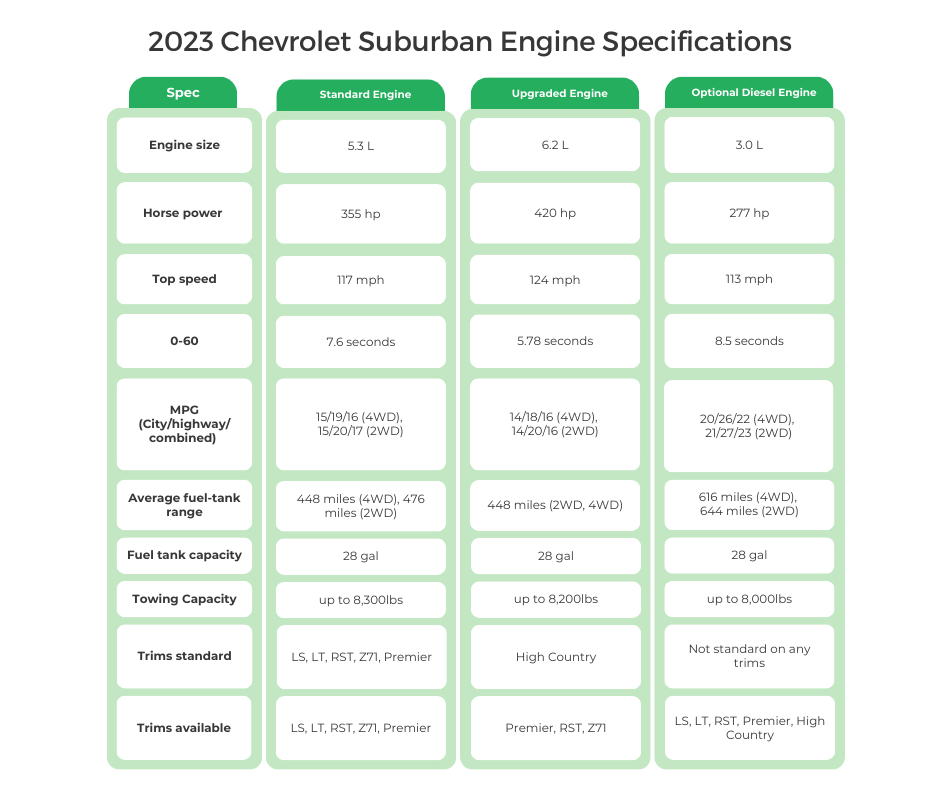
Transmission Options & Specifications:
There’s not much to talk about in the way of transmissions for the Tahoe and Suburban. Both use a ten-speed automatic that is common throughout much of Chevy’s lineup. It’s an advanced gearbox engineered to maximize fuel economy while not hampering performance.
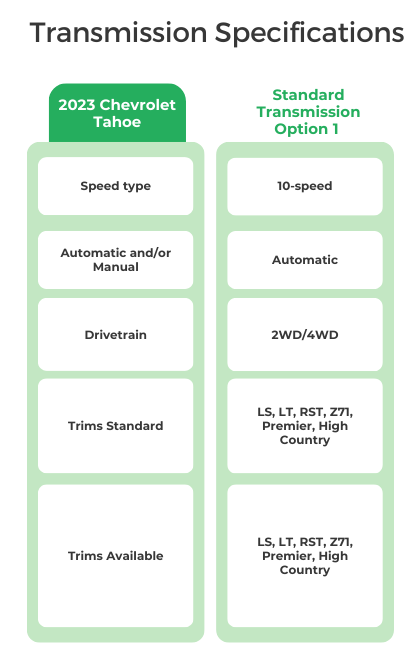

Drivetrain:
While owners in northern climates can’t imagine an SUV without four-wheel drive (4WD), it’s not the case in areas that never see snow. That’s why Chevrolet makes rear-wheel drive (RWD) standard and 4WD optional. A RWD-only vehicle gets better fuel economy and has fewer long-term maintenance issues. However, these benefits are of little value to those who drive on snow-covered highways or regularly deal with muddy roads and trails.
| 2023 Chevrolet Tahoe Wheel Drive | FWD | 4WD | RWD |
| LS | U | S | |
| LT | U | S | |
| RST | U | S | |
| Z71 | U | S | |
| Premier | U | S | |
| High Country | U | S |
| 2023 Chevrolet Suburban Wheel Drive | FWD | 4WD | RWD |
| LS | U | S | |
| LT | U | S | |
| RST | U | S | |
| Z71 | U | S | |
| Premier | U | S | |
| High Country | U | S |
Safety:
NHTSA Safety Ratings
Calling the Tahoe and Suburban family vehicles restates the obvious; that’s what these Chevys are. FIXD surveys also confirm this, with 40% of Tahoe owners using their cars to haul their clan. It’s even higher for the Suburban at 43%. The survey data also reveals that these SUVs are used heavily for commuting and long-distance driving (28% for the Tahoe and 22% for the Suburban).
This precious cargo and all the time behind the wheel mean safety is essential to Tahoe and Suburban owners. In safety testing conducted by the National Highway Traffic Safety Administration (NHTSA), these vehicles performed identically (no surprise): 4 out of 5 in overall performance. This rating isn’t perfect, but a 4 is still respectable.
The Tahoe and Suburban get the same score in frontal crash testing and get a flawless 5 for side crash protection. Both vehicles received a 3 (out of 5) in rollover testing, which isn’t unusual for large, top-heavy SUVs.
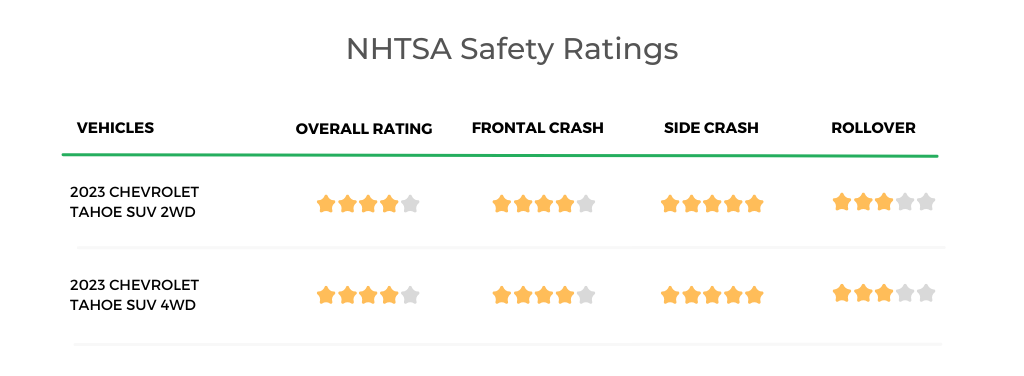

IIHS Awards:
The Insurance Institute for Highway Safety (IIHS) takes a somewhat different approach to safety testing. In particular, it focuses on its small frontal overlap crash test, which the organization feels represents a more real-world scenario (a single car running into a fixed object). IIHS also looks at side impact crashes, roof strength, headlight effectiveness, and advanced driver safety technologies (like automatic emergency braking).
While tested vehicles receive a Good, Acceptable, Marginal, or Poor grade, the true measure comes if a car gets a Top Safety Pick or Top Safety Pick+ designation. If “Good” is a “B” grade, Top Safety Pick notches things up to an “A-,” and the Top Safety Pick+ signifies an “A+.”
IIHS has yet to test the latest generation of the Tahoe and Suburban; Top Safety Pick titles can’t be applied yet. The organization last tested these vehicles in 2020 (the previous generations), so any analysis would be outdated.
| IIHS Award | Tested Vehicle | ||
| 2023 Chevrolet Tahoe | Large SUV/4-door SUV | not available/ not tested | NA |
| 2023 Chevrolet Suburban | Large SUV/4-door SUV | not available/ not tested | NA |
Airbags & Head Restraints:
Airbags are another area where the Tahoe and Suburban are identical. Both vehicles get the standard front row and side-impact setup, including side curtain airbags that protect the rear outboard seats (second and third rows) during a side-impact collision or rollover. Neither Chevy has knee airbags, which better position front-row occupants to reduce accident-related injuries.
Neither the Tahoe nor the Suburban comes with overhead airbags. This newer technology replaces traditional front-row units (steering wheel and dashboard) with overhead devices. Active head restraints are usually found in specialty and high-end vehicles to minimize whiplash injuries. Mainstream cars like the Tahoe and Suburban aren’t usually equipped with this feature.
Semi-Autonomous Driving:
Semi-autonomous driving features in the Tahoe and Suburban are a story of the haves and the have-nots. General Motors’ highly regarded Super Cruise hands-free driving system is optional only on the higher trims (Premier and High Country). On pre-mapped highways, Super Cruise uses a combination of cameras, radars, GPS, and precision map data to enable automated steering, braking, and acceleration in single-lane driving scenarios.
Adaptive cruise control (ACC) is available on the RST and higher trims. ACC uses sensors to detect the speed and distance of vehicles ahead and automatically adjusts the car’s speed to maintain a safe following distance. As needed, ACC slows down the car if vehicles ahead slow down and accelerates it back up to the set speed when the way is clear. However, ACC is not hands-free; drivers must still steer and stay alert. Otherwise, all Tahoes and Suburbans get conventional cruise control.
Enhanced Automatic Parking Assist (available with the Premier and High Country) can steer and brake the vehicle into a parallel or perpendicular parking space detected by the system. However, the driver may have to override the feature in some situations.
Other semi-autonomous driving features fall under the driver aid/safety category (highlighted in the next section). Automatic emergency braking (AEB) will automatically apply the brakes if a potential forward collision is detected. Some Tahoe and Suburban trims can be upgraded to enhanced AEB, which makes the feature functional up to 50 MPH. Base AEB technology incorporates front pedestrian braking, which will also stop the car if a person is detected in the vehicle’s path.
Lastly, reverse automatic braking applies the brakes when an obstacle is detected while the car backs up. Again, this is optional only for high-end Tahoes and Suburbans (Premier and High Country trims).

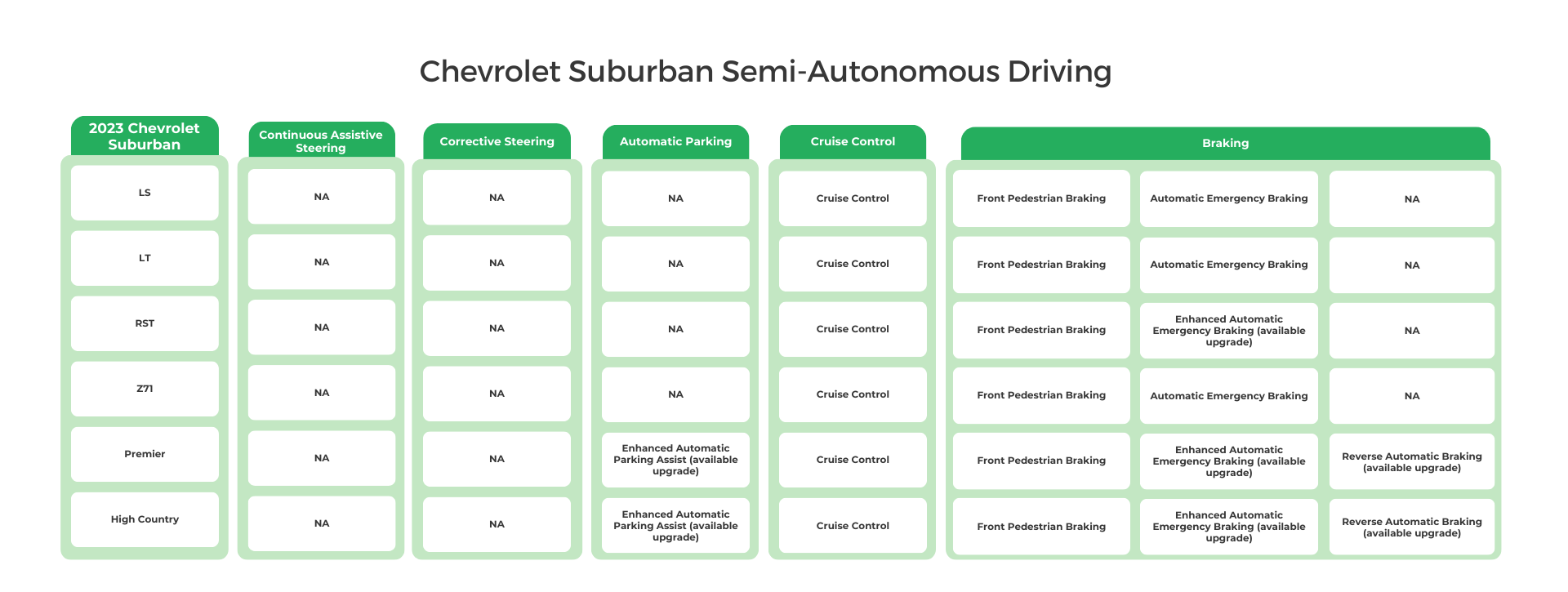
Driver Warning Systems & Telematics:
The Tahoe and Suburban come standard with many advanced driver assistance systems (ADAS), technologies designed to limit or stop accidents. In addition to AEB, all trims get forward collision warning (FCW) and lane departure warning (LDW). FCW warns drivers of obstacles ahead, while LDW alerts when the vehicle drifts out of its lane.
Depending on the trim, blind-spot monitoring and rear cross-traffic alert (RCTA) are optional or standard on the Tahoe and Suburban.
If ADAS technology appears like alphabet soup, check out an effort from AAA, Consumer Reports, J.D. Power, and other groups working to standardize the terminology for these systems.
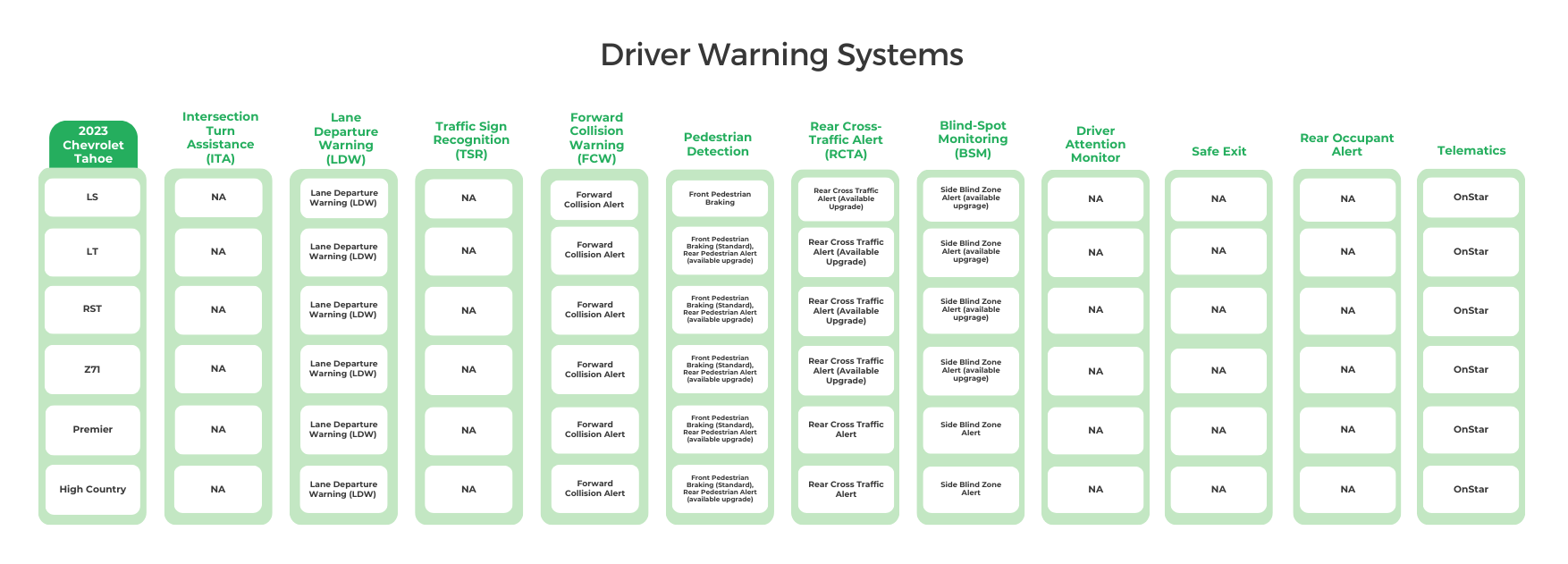
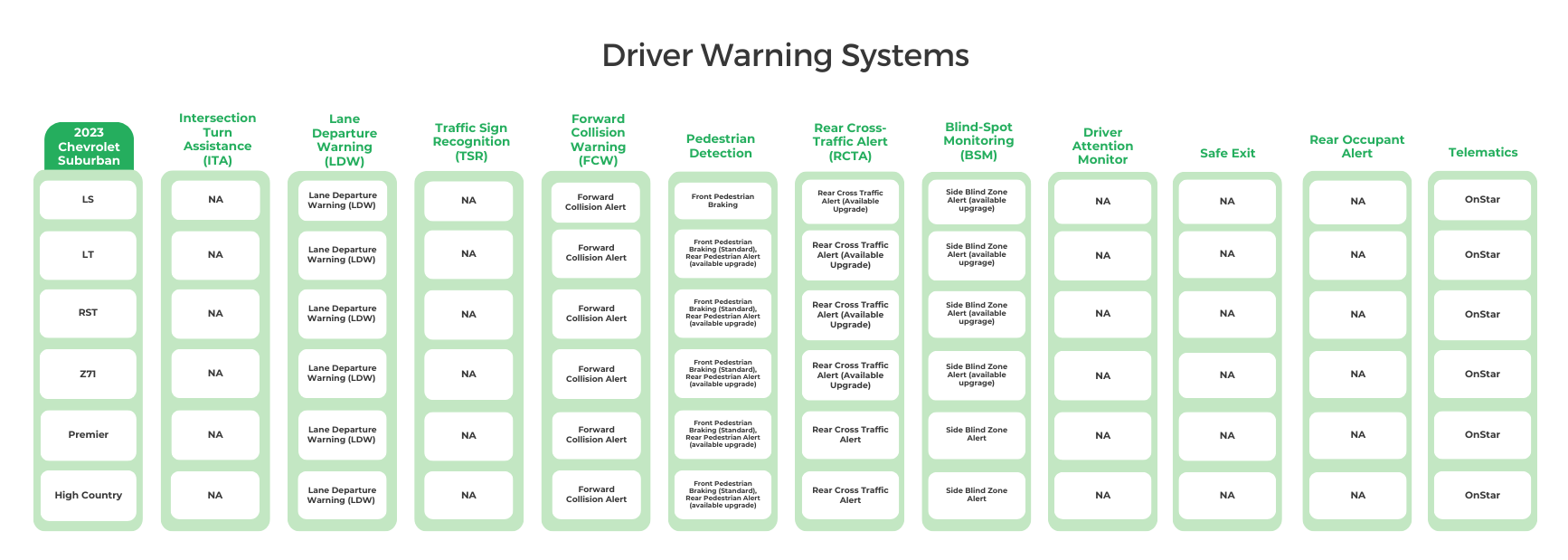
Road Visibility Features:
While some Tahoes and Suburbans don’t come with all the advanced safety gear (or require an upgrade), Chevy equips all of its full-sized SUVs with LED headlights and automatic high beams. Other standard visibility features include rain-sensing windshield wipers (often an extra cost on other SUVs) and a rearview camera (a federal requirement).
However, like other cutting-edge features, a head-up display is reserved only for the upper trims. This tech projects speed and additional vital information onto the windshield. It’s standard on the High Country and optional on the Premier.

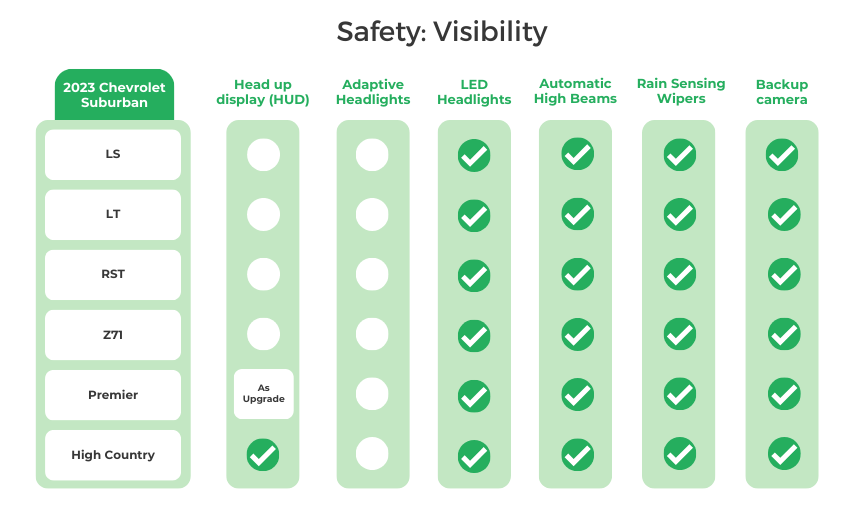
Interior:
Interior Features:
Not wanting to give an edge to competitors, Chevrolet makes Apple CarPlay and Android Auto standard on all Tahoe and Suburban versions.
It’s almost the same with heated front seats, as this feature is included with most versions. Heated front seats are unavailable with the base Tahoe LS and Suburban LS.
And speaking of heated seats, some automakers offer this feature through a subscription service. This hasn’t yet happened in the U.S., but in certain countries, BMW offered heated seats for a monthly fee. The advantage is you can shut off the service during warm months, but you’ll need to keep paying (or pay a one-time upfront fee) to activate the heated seats. Recently, BMW announced it was backing away from this practice. Moving forward, the automaker will only charge a subscription for software-based services (like upgraded navigation). Hardware-based features will be part of the vehicle’s initial purchase price.
One industry study shows mixed results for consumer acceptance of features on demand (FoD), with about one-fifth not even being aware of the concept.

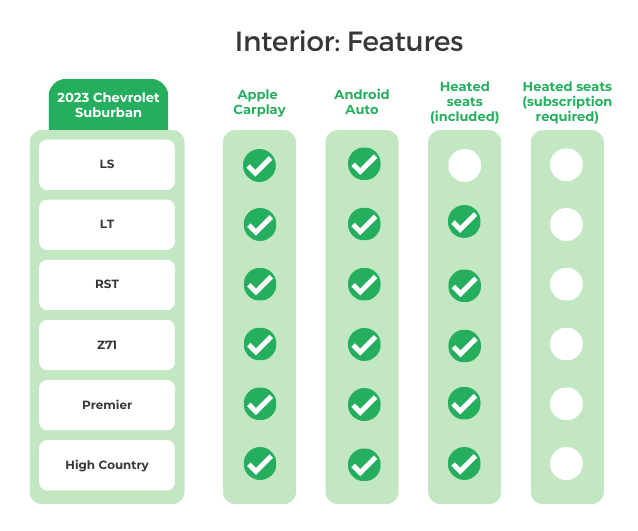
Interior Dimensions:
Regardless of whether you consider the Tahoe a shortened version of the Suburban or the Suburban a stretched-out Tahoe, interior dimensions truly separate these Chevys.
Let’s dive into the details. This starts with rear legroom, with the Suburban offering 42 inches in the second row, compared to 39 inches for the Tahoe. At the back of the bus, the Tahoe has 35 inches in the third row, against 37 inches for the Suburban.
Cargo space is also a divider. Behind the first row, the Suburban has 94 cubic feet, while the Tahoe offers 73 cubic feet. This gap is also noticeable when all three rows are in use. Behind the back seat, the Suburban has 41.5 cubic feet, topping the Tahoe’s 25.5 cubic feet.
Otherwise, key interior dimensions like front legroom and headroom are identical.
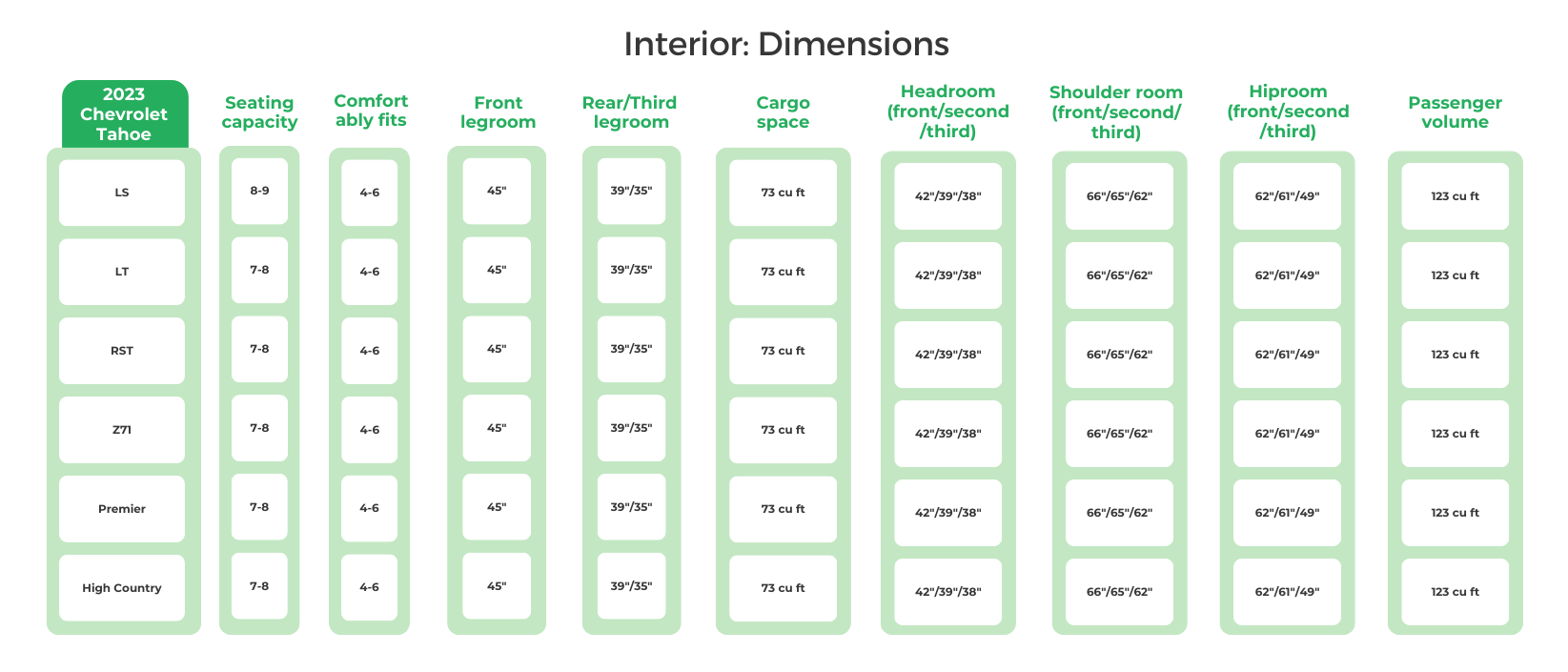

Exterior:
Exterior Features:
Wheels may also be an afterthought for many car buyers. But wheel size can impact ride quality. Larger rims can translate into better traction and cornering but may result in a bumpier ride. Bigger wheels also offer better aesthetics by filling out the wheel wells more completely. This is why the higher the trim, the larger the wheel. Different materials (steel or alloy) and finishes also help separate the wheels among the various trim levels.
While the Tahoe and Suburban stand out for their size, the available colors for these Chevys certainly don’t. Exterior shades are typical for most new vehicles these days: black, white, gray, and silver. Midnight Blue Metallic won’t turn any heads either. If bright colors are a must-have, the closest you’ll get is Radiant Red Tricoat (a darkish red).

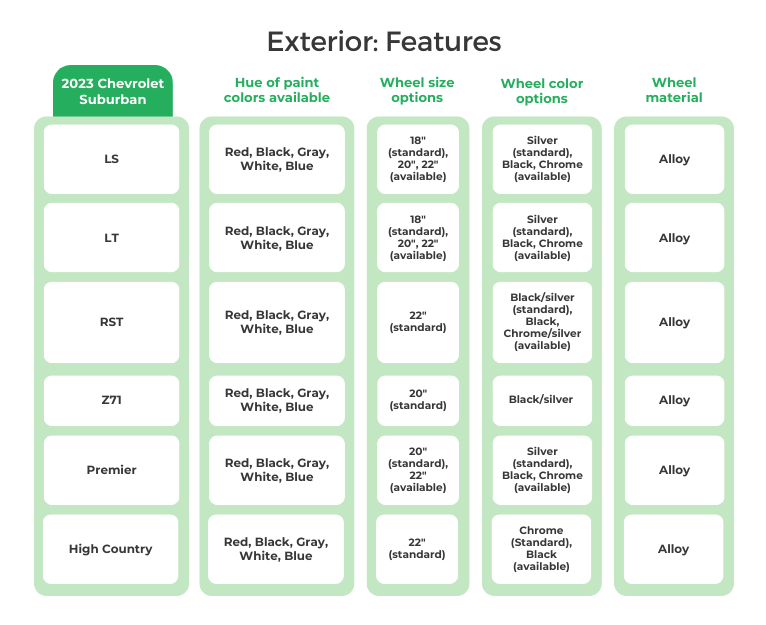
Exterior Dimensions:
We can summarize the Tahoe’s and Suburban’s exterior size in a few words: large and extra large. These are vehicles best kept in an extra-wide driveway or spacious above-ground parking lot. And not every home garage can handle these jumbo Chevys.
At 226 inches, the Suburban is one of the longest vehicles on the road today. Even the 211-inch length of the Tahoe may be a challenge. Along with the different sizes come distinct wheelbase measurements: 121 inches for the Tahoe and 134 inches for the Suburban. The wheelbase variance explains the legroom contrasts between the two. And you may find the Suburban offers a more comfortable ride thanks to an extra 13 inches between the axles.


Warranty
Chevy’s warranty coverage for the Tahoe and Suburban is the same. A bumper-to-bumper warranty protects both for three years or 36,000 miles, while a powertrain (engine, transmission, and drive axles) plan lasts for five years or 60,000 miles. Interestingly, Chevy includes roadside assistance for five years (or 60,000 miles), while most mainstream brands stop after two or three years.
| 2023 Chevrolet Tahoe Factory Warranty Coverage: | 2023 Chevrolet Suburban Factory Warranty Coverage: | |
| Basic warranty: | 36 months/36,000 miles | 36 months/36,000 miles |
| Powertrain warranty: | 60 Months/60,000 miles | 60 Months/60,000 miles |
| Corrosion perforation warranty: | 36 months/36,000 miles (body/sheet metal corrosion), 72 months/100,000 miles (rust-through) | 36 months/36,000 miles (body/sheet metal corrosion), 72 months/100,000 miles (rust-through) |
| Air conditioning warranty: | included in Basic Warranty | included in Basic Warranty |
| Battery warranty: | NA | NA |
| Emissions warranty: | 24 month/24,000 miles (federal), 36 months/50,000 miles (California) | 24 month/24,000 miles (federal), 36 months/50,000 miles (California) |
| Roadside assistance coverage: | 60 Months/60,000 miles | 60 Months/60,000 miles |
| Total unique recalls: | 1 (recall no. 22V903000) | 1 (recall no. 22V903000) |
Driver Experience | A Summary of The Top 10 Chevrolet Suburban vs. Chevrolet Tahoe Reddit Posts:
When choosing between the Chevrolet Suburban and Tahoe, most Redditors on the r/whatcarshouldIbuy subreddit prefer the Tahoe for daily driving and family needs. One user commented, “The Tahoe is much more practical as a daily driver and family hauler. The Suburban is massive and cumbersome.” The extra size and capacity of the Suburban come at the cost of unwieldy handling and difficulty parking, with one user stating, “Test drove both. Loved the space of the Suburban but it was just too unwieldy for my needs.”
The consensus seems to be that “the conveniences of the Tahoe outweigh the extra space in the Suburban” for the average driver.
While the Chevrolet Suburban offers maximum cargo and passenger room, it is seen as impractical for most buyers. As one Redditor put it, “I’d only go with a Suburban if you absolutely need the gigantic size. It’s not very practical.” The Tahoe provides ample space for passengers and gear for the majority of buyers in a more manageable package.
As summed up by one comment, “Looking at both myself. Leaning toward the Tahoe for the better driving dynamics and ease of parking. Suburban is just so freaking huge.” For hauling larger families and cargo, the Suburban can’t be beaten. But for daily driving and family needs, most recommend the Chevrolet Tahoe.
Who Should Buy These Cars: The Legacy of The Chevrolet Suburban and Chevrolet Tahoe
The three rows of the Tahoe and Suburban make them ideal for family transportation, something we covered earlier. Their sheer bulk makes these Chevys comfortable cruisers for “lots of driving” (long-distance traveling and commuting). We know these vehicles can handle these duties for a long time as FIXD owner surveys report the Tahoe and Suburban regularly reach 150,000-200,000 miles.
| Frequent Use Categories: | Chevrolet Tahoe | How Useful? (Out of 5 Stars) | Chevrolet Suburban | How Useful? (Out of 5 Stars) |
| Family Vehicle | **** | ***** |
| Lots of Driving (travel/long commute) | *** | *** |
| Hauling/Towing | ** | ** |
| Office on Wheels | * | * |
| Sport/Fast Driving | * | * |
| Luxurious Driving | * | * |
| Outdoor/Off-Road | * | * |
Best & Worst Years | Chevrolet Suburban vs. Chevrolet Tahoe | 2001-2024

Shoppers on a tight budget and looking for a full-sized Chevy SUV have an easy choice. Only the 2005 Suburban and 2006 Tahoe are worth buying. As we’ve covered in individual articles on the Suburban and Tahoe, most older editions have reliability issues.
You’ll need to move to at least a 2011 model year before there is a better selection. Still, you’ll need to be cautious of the worst-year examples (2013 Suburban and 2012, 2014-2015, and 2021 Tahoe).
Fortunately, several model years balance modernity and affordability. Check out the 2016-2017 and 2019 Suburban and 2016-2020 Tahoe. These represent the previous generations, often selling for much less than the current edition.
We’ll call attention to the undecided years (yellow) only because there isn’t enough information to give these editions a thumbs up or down.
Important Features Timeline | Chevrolet Suburban vs. Chevrolet Tahoe
The Suburban and Tahoe share roles as Chevy’s flagship SUVs. As such, it’s highly unusual for one to get a feature before the other. Both are built at the same factory and are basically the same vehicle other than the mentioned size differences.
So, when the Suburban got advanced safety features like blind-spot monitoring and lane departure warning, as did the Tahoe. Likewise, when Chevy added comfort and convenience equipment to the Suburban (for example, heated front seats and a power front passenger seat), it also became part of the Tahoe’s feature set.
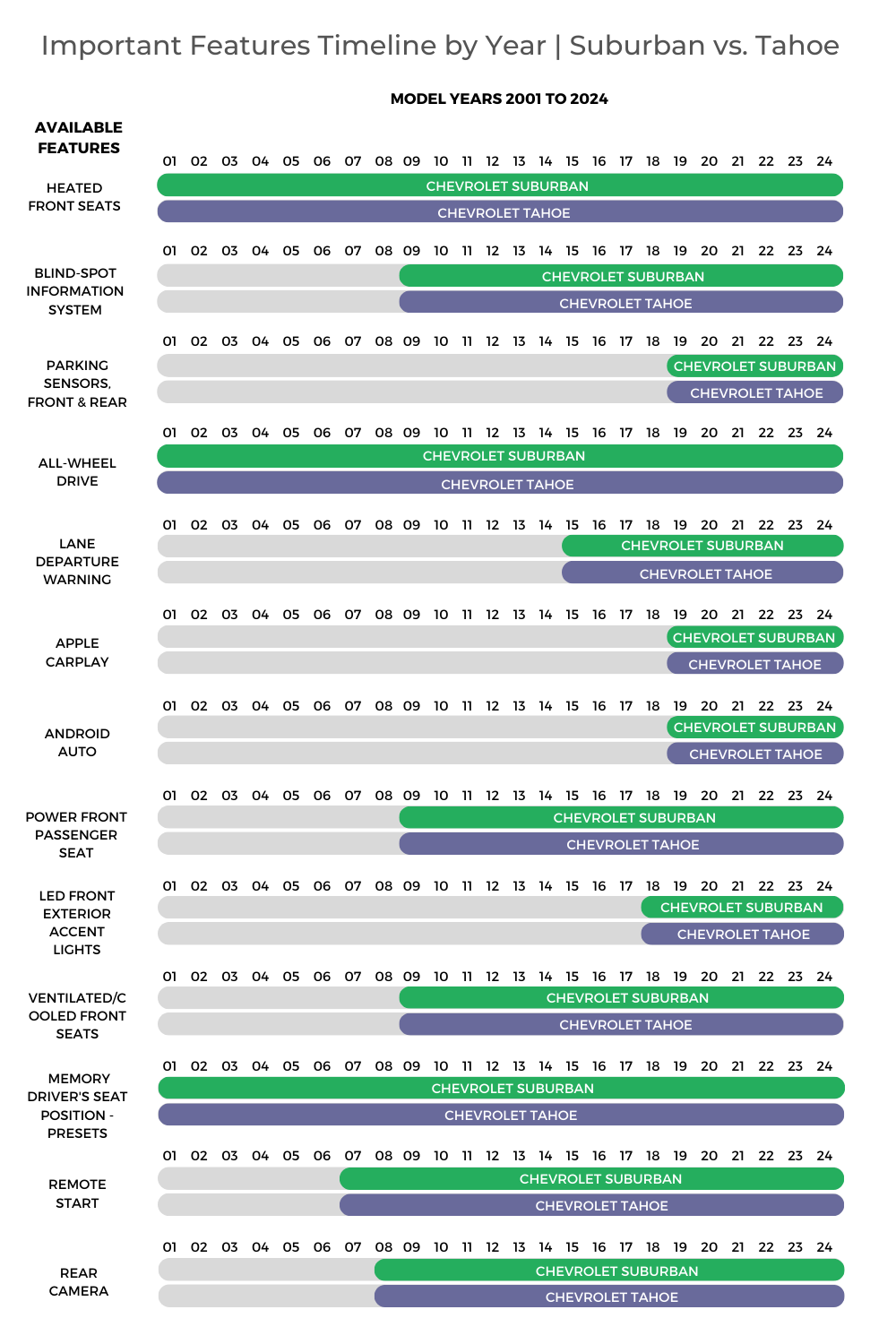
Maintenance Costs (Year-by-Year Average) | Chevrolet Suburban vs. Chevrolet Tahoe
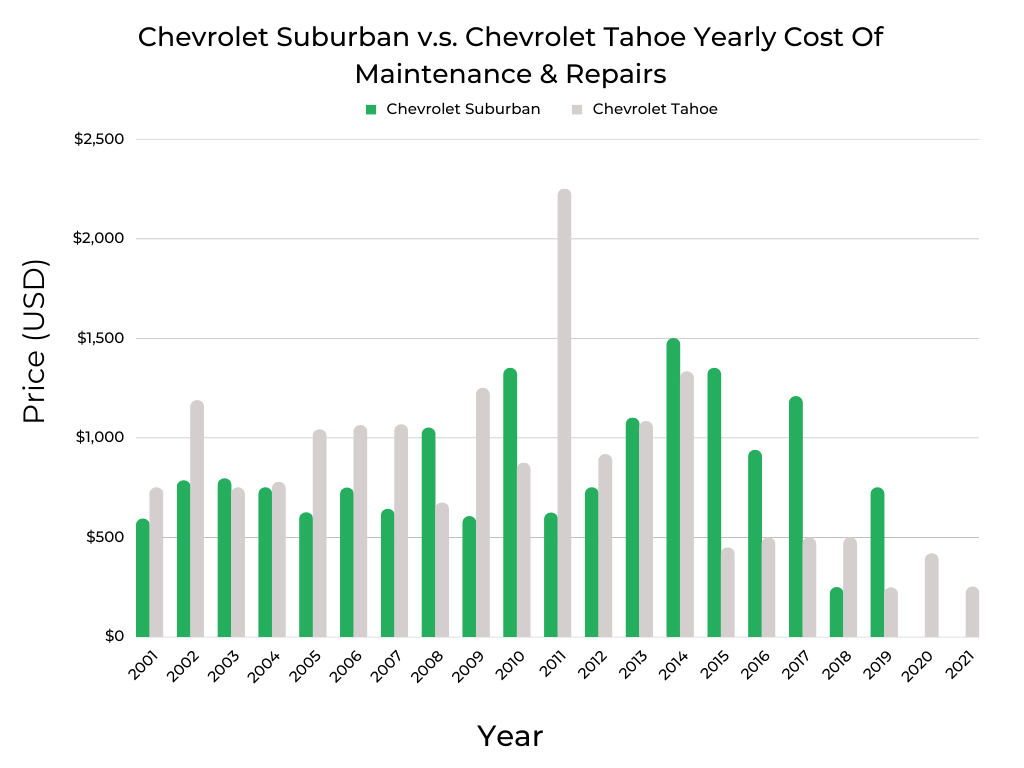
Based on FIXD survey data, the average Suburban owner spent $864 on maintenance and repairs in 2022. That’s almost identical to what Tahoe owners paid: $852. This similarity is expected because these vehicles share engines, transmissions, and every other component. We’d be surprised if these numbers didn’t match up.
That said, owning a Suburban or Tahoe is more expensive than most vehicles. RepairPal says that the average car requires $652 in yearly upkeep. So, keeping a big Chevy SUV in the driveway costs an extra 30%.
According to owner surveys, specific model years have above-average maintenance and repair bills. This means the 2008, 2010, 2013-2015, and 2017 model years for the Suburban and the 2002, 2005-2007, 2009, 2011, and 2013-2014 editions for the Tahoe—something to consider when shopping. The 2014 Suburban and 2011 Tahoe are particularly costly to keep in working condition.
Keep in mind that repair bills can vary by individual vehicle. An owner focused on keeping up with scheduled maintenance and addressing problems early may be able to avoid costly issues that neglectful people can’t.
Review the best and worst years of the Chevrolet Suburban and Chevrolet Tahoe to learn more about maintenance and repair costs for these vehicles.
Safety Rating Comparison | Chevrolet Suburban vs. Chevrolet Tahoe

As mentioned, the benchmark for good or better NHTSA safety testing begins at 4 (out of 5). Older Suburbans and Tahoes (2001-2006) aren’t up to this standard, but the introduction of a new generation for the 2007 model year shows significant improvement.
Suburban ratings dropped for 2011. However, this reduction is due to new testing standards that affected most automakers. Chevy was able to get the Suburban back up to speed for 2012. Interestingly, the Tahoe wasn’t affected by the change; the reason for this is uncertain.
Otherwise, the Suburban and Tahoe crash test scores are mostly similar, except for the 2015-2018 editions. If you need a reason to select between a Suburban or a Tahoe from these model years, the Tahoe’s slightly better testing may be the deciding factor.
More details about crash test safety scores are covered in articles about the Chevrolet Suburban and Chevrolet Tahoe.
Fuel Efficiency Comparison | Chevrolet Suburban vs. Chevrolet Tahoe
There’s not much to talk about with fuel economy for the Suburban and Tahoe. After all, gas-sipping is not one of the characteristics of large SUVs. With a gas engine, neither the Suburban nor the Tahoe averages 20 MPG. No one buys a Suburban or Tahoe to save at the pump.
Chevrolet did offer a hybrid-powered Tahoe for a few years (2008-2013), but the extra cost was hard to justify. The additional 3-5 MPG over a conventional gas engine wasn’t worth it for most buyers; Chevy sold very few Tahoe Hybrids.
Methodology
- Compare two vehicles, Chevrolet Suburban and Chevrolet Tahoe, and provide a comprehensive analysis.
- Gather relevant information and data on both vehicles from reliable sources, such as manufacturer specifications, expert reviews, customer feedback, industry reports, and data sources like manufacturer websites, FIXD App, Kelley Blue Book, FuelEconomy.gov, and NHTSA.
- Collect data on various aspects, including performance, safety features, fuel efficiency, maintenance costs, reliability, owner satisfaction, and market value.
- Identify the key criteria that will be used to evaluate and compare the two vehicles.
- Ensure the criteria cover both objective factors (such as performance metrics, safety ratings, and fuel efficiency) and subjective factors (such as owner satisfaction, comfort, and features).
- Assess the performance of both vehicles based on factors such as acceleration, handling, braking, and overall driving experience.
- Compare engine options, horsepower, torque, transmission options, and any unique performance features.
- Examine the safety features and ratings of both vehicles.
- Evaluate crash test ratings, advanced driver assistance systems (ADAS), active and passive safety features, and any notable recalls or known issues related to safety.
- Consider both NHTSA safety ratings and IIHS awards for a comprehensive safety assessment.
- Analyze the fuel economy of both vehicles based on EPA mileage estimates.
- Compare their MPG ratings, average full-tank range, and any significant differences in fuel efficiency.
- Assess the average annual maintenance and repair costs for both vehicles.
- Consider data from surveyed owners and other reliable sources, such as FIXD App owner surveys, to determine the overall cost of ownership over time.
- Evaluate the reliability of both vehicles based on owner reports, FIXD App data, and any known issues or recalls.
- Consider factors such as engine reliability, common problems by model year, long-term durability, and owner reliability scores gathered from surveys.
- Consider owner satisfaction by gathering information from forums, online communities (Reddit: r/whatcarshouldIbuy), customer reviews, and owner reliability scores.
- Summarize key factors that owners appreciate and any common complaints or drawbacks mentioned by owners.
- Compare the features and technologies offered by both vehicles.
- Highlight any notable differences in terms of infotainment systems, connectivity options, driver assistance features, interior quality, and available upgrades.
- Assess the market value and depreciation of both vehicles.
- Compare average prices, resale value, and how the vehicles hold their value over time.
- Consider average private-seller valuations from Kelley Blue Book (KBB) for a comprehensive assessment.
- Summarize the findings of the comparison, highlighting the positives and negatives of each vehicle.
- Provide a fair and balanced recommendation based on the comparison, considering factors such as budget, personal preferences, specific needs of the buyer, and the comprehensive analysis conducted.
Sources:
-
- KBB Values: Average private-seller valuations as supplied by Kelley Blue Book (KBB), based on a Chevrolet Equinox with typical mileage for that respective model year.
- Fuel Economy: Mileage-per-gallon estimates according to the EPA MPG on Fueleconomy.gov.
- Annual Maintenance/Repairs: Upkeep expenses as reported by surveyed Chevrolet Equinox owners.
- Safety Ratings: Crash test data collected and reported by NHTSA. We average all ratings for each year to come up with a simplified, average safety score. This makes it easier to look at on a graph. We also collected IIHS Awards for this article.
- Vehicle Features: Most or all information gathered on vehicle features was from the manufacturer’s website, in this case, Chevrolet.com.

Dave Goldberg is an automotive journalist and lifelong car fanatic. He writes for numerous enthusiast and business outlets and is an ongoing contributor to HotCars.com, one of the most popular car culture websites. When he’s not writing or driving, Dave is either under a hood or asleep. His credentials include a BA in Journalism from The George Washington University.

